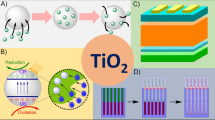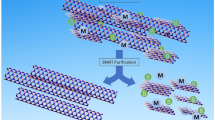Abstract
Titanate nanotubes were synthesized by hydrothermal process using commercial titania nanoparticles. The experiments were carried out as a function of reaction time, temperature, and NaOH concentration. Furthermore, the titanate nanotube film was fabricated on the Si substrate using electrodeposition method with 60 V and at room temperature. The specimens were investigated by using various techniques such as field-emission scanning electron microscopy (FESEM), transmission electron microscopy (TEM), X-ray diffraction (XRD), Raman Spectroscopy, and Xray photoelectron spectroscopy (XPS). The formation of sodium titanate nanotubes was affected strongly by the variation in all parameters. The best conditions for the titanate nanotubes were found to be a reaction temperature of 150°C, 10 M NaOH concentration, and reaction time of 48 hr. Under the best conditions, the resulting titanate nanotubes did not contain any remains of starting material, namely P25 nanoparticles, and also the resulting nanotubes had very smooth morphology with a diameter of ∼10 nm and length extending up to several micrometers without presence of any bundlelike structures. The washing of sodium titanate nanotubes with HCl solution leads to conversion into protonic titanate nanotubes via ion exchange reaction. The subsequent sintering of the titanate nanotubes renders dehydration of interlayered OH groups, thereby leading to precipitation of anatase phase. The tubular structure also gets destroyed during phase change, beyond 375°C. The electrodeposited titanate film with 60 V for 10 min at room temperature was dense and uniform. In this work, we suggest that electrochemical deposition method of titanate nanotubes film can be used for its applications.
Similar content being viewed by others
References
Chen, Q., Du, G. H., Zhang, S. and Peng, L. M., “The structure of trititanate nanotubes,” Acta Crystallogr. B, 58, 587 (2002).
Chen, Q., Zhou, W., Du, G. and Peng, L. M., “Trititanate nanotubes made via a single alkali treatment,” Adv. Mater., 14, 1208 (2002).
Chevaleevski, O. and Larina, L., “New trends in solar photovoltaics: From physics to chemistry,” Korean J. Chem. Eng., 18, 403 (2001).
Du, G.H., Chen, Q., Che, R. C., Yuan, Z.Y. and Peng, L.M., “Preparation and structure analysis of titanium oxide nanotubes,” Appl. Phys. Lett., 79, 3702 (2001).
Fujishima, T. and Honda, K., “Electrochemical photolysis of water at a semiconductor electrode,” Nature, 238, 37 (1972).
Godbole, V. P., Kim, G. S., Dar, M.A., Kim, Y. S., Seo, H.K., Khang, G. and Shin, H. S., “Hot filament chemical vapour deposition processing of titanate nanotube coatings,” Nanotechnology, 16, 1186 (2005).
Hoyer, P., “Formation of a titanium dioxide nanotube array,” Langmuir, 12, 1411 (1996).
Imai, H., Takei, Y., Matsuda, M. and Hirashima, H., “Direct preparation of anatase TiO2 nanotubes in porous alumina membranes,” J. Mater. Chem., 9, 2971 (1999).
Kasuga, T., Hiramatsu, M., Hoson, A., Sekino, T. and Niihara, K., “Formation of titanium oxide nanotube,” Langmuir, 14, 3160 (1998).
Kasuga, T., Hiramatsu, M., Hoson, A., Sekino, T. and Niihara, K., “Titania nanotubes prepared by chemical processing,” Adv. Mater., 11(15), 1307 (1999).
Kim, G.-S., Godbole, V. P., Seo, H.-K., Kim, Y.-S. and Shin, H.-S., “Sodium removal from titanate nanotubes in electrodeposition process,” Electrochemistry Communication, 8, 471 (2006).
Kim, J. S. and Lee, T. K., “Effect of humidity on the photocatalytic degradation of trichloroethylene in gas phase over TiO2 thin films treated by different conditions,” Korean J. Chem. Eng., 18, 935 (2001).
Kim, J. H., Noh, B. H., Lee, G.-D. and Hong, S.-S., “Hydrothermal synthesis of titanium dioxide using acidic petizing agents and their photocatalytic activity,” Korean J. Chem. Eng., 22, 370 (2005).
Kim, S.-H., Umar, A. and Hahn, Y.-B., “Growth and formation mechanism of sea urchin-like ZnO nanostructures on Si,” Korean J. Chem. Eng., 22, 489 (2005).
Lee, B.-Y., Park, S.-H., Lee, S.-C., Kang, M., Park, C.-H. and Choung, S.-J., “Optical properties of Pt-TiO2 catalyst and photocatalytic activities for benzene decomposition,” Korean J. Chem. Eng., 20, 812 (2003).
Lee, J., Nam, S.C. and Tak, Y., “On the origin of electrodeposition mechanism of ZnO on ITO substrate,” Korean J. Chem. Eng., 22, 161 (2005).
Moulder, J. F., Stickle, W. F., Sobol, P. E. and Bomben, K.D., Handbook of X-ray photoelectron spectroscopy, Physical Electronics, Inc. Eden Praire, Minnesota 55344, USA (1992).
Na, Y., Song, S. and Park, Y., “Photocatalytic decolorization of rhodamine B by immobilized TiO2/UV in a fluidized-bed reactor,” Korean J. Chem. Eng., 22, 196 (2005).
Nam, W. S. and Han, G.Y., “A photocatalytic performance of TiO2 photocatalyst prepared by the hydrothermal method,” Korean J. Chem. Eng., 20, 180 (2003).
Oh, C.W., Lee, G.-D., Park, S. S., Ju, C.-S. and Hong, S.-S., “Preparation of nanosized TiO2 particales via ultrasonic irradiation and their photocatalytic activity on the decomposition of 4-nitrophenol,” Korean J. Chem. Eng., 22, 547 (2005).
O’Regan, B. and Gratzel, M., “A low-cost, high-efficiency solar cell based on dye-sensitized colloidal TiO2 films,” Nature, 353, 737 (1991).
Powell, C. J., “Elemental binding energies for X-ray photoelectron spectroscopy,” Applied Surface Science, 89, 141 (1995).
Seo, D. S., Lee, J. M. and Kim, H., “Preparation of nanotube-shaped TiO2 powder,” J. Cryst. Growth, 229, 428 (2001).
Sun, X. and Li, Y., “Synthesis and characterization of ion-exchangeable titanate nanotubes,” Chem. Eur. J., 9, 2229 (2003).
Yao, B. D., Chan, Y. F., Zhang, X.Y., Yang, W.Y. and Wang, N., “Formation mechanism of TiO2 nanotubes,” Appl. Phys. Lett., 82, 281 (2003).
Zhang, S., Li, W., Jin, Z., Yang, J., Zhang, J., Du, Z. and Zhang, Z., “Study on ESR and inter-related properties of vacuum-dehydrated nanotubed titanic acid,” J. Sol. State Chem., 177, 1365 (2004).
Author information
Authors and Affiliations
Corresponding author
Rights and permissions
About this article
Cite this article
Kim, GS., Kim, YS., Seo, HK. et al. Hydrothermal synthesis of titanate nanotubes followed by electrodeposition process. Korean J. Chem. Eng. 23, 1037–1045 (2006). https://doi.org/10.1007/s11814-006-0027-x
Received:
Accepted:
Issue Date:
DOI: https://doi.org/10.1007/s11814-006-0027-x




